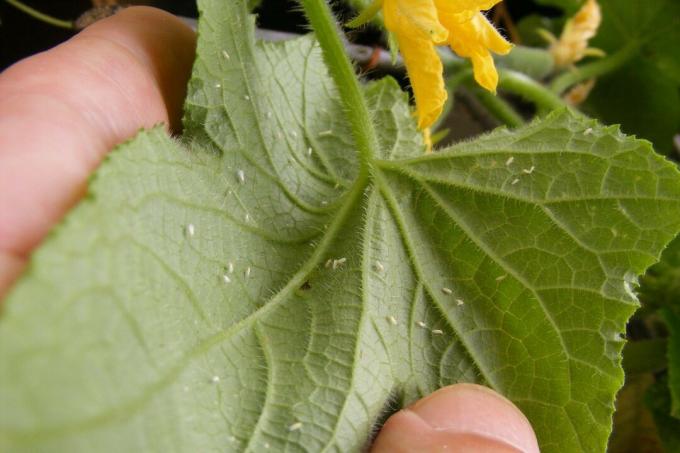Beneficial organisms have been used successfully in organic tomato cultivation for a long time. We reveal how ladybugs and co. Can help fight pests on tomatoes.

In nature, insects keep each other in check and thus ensure a natural balance. As a result, there is hardly any overabundance of harmful insects that could endanger a plant population. So-called beneficial insects can be used in a targeted manner in both private and commercial cultivation, which fight certain pests in a natural way. This saves the use of pesticides and the often toxic substances do not get into the environment. The term “beneficial organism” only refers to the benefits of animals for humans, not to the biological value of insects or animals in nature.
contents
- Beneficial organisms against aphids on tomatoes
- Beneficial insects against whiteflies on tomatoes
- Beneficial organisms against spider mites in tomatoes
- Beneficial organisms against leaf miners on tomatoes
- All beneficial insects against the most common tomato pests in one table
- Sources of supply for beneficial tomatoes
Beneficial organisms against aphids on tomatoes
Aphids (Aphidoidea) suck sugar juice from the ducts of tomato leaves and young shoots, which often leads to deformations such as strangely kinked or twisted leaves. Come against aphids Ladybug (Coccinellidae), Predatory Gall mosquitoes (Aphidoletes aphidimyza) as Lacewing (Chrysoperla carnea) and Hoverflies (Episyrphus baltiatus) for use.
- Ladybirds and their elongated, orange-black striped larvae devour dozens of aphids every day. The larvae create around 800 aphids after about four weeks, the adult beetles of the well-known seven-spotted ladybird (Coccinella septempunctata) eat up to 150 aphids per day. For example, the two-point ladybirds (Adalia bipunctata).
- Predatory gall mosquitoes lay their eggs in the vicinity of aphid colonies in their usually only one week long life. The orange larvae hatch after three to seven days and immediately start sucking out the annoying plant suckers themselves. After about two weeks, the larvae pupate and fall from the plants. Now a new generation has to be brought out if the infestation is not over yet.
- In lacewings, too, it is only the larvae that feast on aphids. The sand-colored, elongated creatures have large mouthparts with which they can consume around 500 aphids per larva in two to three weeks.
- Hoverflies camouflage themselves as adult animals with wasp-like colors, but have no sting and only feed on flowers. Their larvae, however, are always hungry companions and until they are vegetarian as adults they tirelessly eat aphids. In the two weeks until pupation, a larva clears up to 700 aphids.
In our article on the Aphid Control learn how to quickly and safely remove aphids using effective home or biological remedies like ours Plantura organic pest-free neem Get rid of.
Beneficial insects against whiteflies on tomatoes
Whiteflies (Trialeurodes vaporariorum) often appear en masse in the greenhouse. They like to lay their eggs on the underside of tomato leaves. Their larvae are also called whitefish because they are whitish and very broad, just like the name suggests, shield-shaped. If you shake the plant, the winged adults fly up. Parasitic wasps (Encarsia formosa, Eretmocerus eremicus), Predatory mites (Amblyseius swirskii) and Predatory bugs (Macrolophus pygmaeus) are antagonists of the whitefly. The parasitic wasps lay their eggs on the whiteflies, their larvae feed on the louse and thereby kill them. In commercial horticulture, the parasitic wasp has become indispensable as a very effective beneficial insect against whitefly. Predatory mites are so-called protective predators that do not allow pests to multiply on a large scale in the first place. They do not eat as many lice as parasitic wasp larvae, but they reproduce on the plants themselves and remain with enough prey until they can no longer find anything to eat. All of the beneficial insects mentioned can be ordered and used on the infested plants immediately after delivery.

Beneficial organisms against spider mites in tomatoes
The dreaded Spider mites (Tetranychus urticae) occur on fruit trees and ornamental plants, but also on many types of vegetables. They are often orange-red in color and pierce plant cells that are sucked out and then turn whitish. In this way, spotty leaf surfaces and later also webs between leaves that are reminiscent of cobwebs are created. The predatory gall mosquito (Feltiella acarisuga) helps against spider mites, but the most effective antagonist is the predatory mite (Phytoseiulus persimilis). Adult predatory mites eat around five spider mites a day and can keep them in check for a long time. Even the smallest genus of ladybugs Stethorus, or ball beetle, with a length of only 1.2 millimeters successfully fights spider mites, also on fruit trees. The small beetles are completely black with yellow legs.

Beneficial organisms against leaf miners on tomatoes
There is an infestation with in the home garden Leaf miners (Agromyzidae) rather seldom. The larvae of these insects eat their way through the leaf between the top and bottom of the leaf, leaving behind visible, light to white, curved and diffuse-looking feeding tunnels. The parasitic wasps of the species also help against this pest Dacnusa sibirica and Diglyphus isaea. These parasitic wasps also lay eggs in the larvae and let their own offspring do the rest.
All beneficial insects against the most common tomato pests in one table
In the table below you can see all tomato pests, their symptoms and their opponents summarized. Because the German names of beneficial insects are usually not precise enough, you will find the Latin names. You can use these better when looking for beneficial insects.
| pest | symptom | Beneficial organism |
|---|---|---|
| aphid | Lice clearly visible; sticky leaves; twisted leaves; deformed stems | Ladybug: Adalia bipunctata, Gall mosquito: Aphidoletes aphidimyza, Lacewing: Chrysoperla carnea, Hoverfly: Episyrphus baltiatus |
| Whitefly | Soaring white flies; deformed leaves | Parasitic wasps: Encarsia formosa, Eretmocerus eremicus, Predatory mite: Amblyseius swirskii, Predatory bug: Macrolophus pygmaeus |
| Spider mite | Blotchy white-green leaves; Cobwebs; Red mites | Gall mosquito: Feltiella acarisuga, Predatory mite: Phytoseiulus persimilis |
| Leaf miner | White mining tunnels inside the leaf | Parasitic wasps: Dacnusa sibirica, Diglyphus isaea |
All of these beneficial insects can be purchased in the form of eggs or larvae. Recommended sources can be found below in the text. The eggs are delivered in different packaging and placed in the infested plant stock immediately after arrival according to the manufacturer's instructions. After a few days, the larvae hatch and get to work. Once they have developed enough, they pupate and become adults. Not all beneficial insects can be used everywhere without any problems. An armada of ladybirds can be quite annoying indoors, and parasitic wasps in the field have a tendency to simply fly away from the treated plant. It is therefore important to observe the information provided by the providers of living beneficial insects.

Not only animal helpers can protect the tomato from pests. If you take the term “beneficial organism” a little further and also include plants, they are allowed to Marigold (Tagetes sp.) and Marigold (Calendula officinalis) not missing. If you plant these beautiful ornamental plants together with tomatoes, they protect the tomato roots from nematodes. In our article on the Mixed cultivation of tomatoes learn which plants are the best neighbors for tomatoes.
tip: Even Bumblebees (Bomb sp.) belong to the beneficial organisms, because they are already active at temperatures at which no bee dares to venture out. Bumblebees ensure the pollination of tomatoes in the home garden as well as in the greenhouse. Bumblebees have become indispensable as a pollination aid in commercial horticulture.
Sources of supply for beneficial tomatoes
Some beneficial insects can even be found in well-stocked garden centers such as Dehner garden centers. However, the choice there is often very limited. A larger company in Germany is Sautter & Stepper GmbH from Ammerbuch, which offers a wide range of beneficial organisms online at nuetzlinge.de. But also nurseries such as Native Plants keep the animals ready via their online shop. You have to reckon with around 10 to 15 euros per pack. The price pays off quickly, however, as sprays are similarly expensive and you certainly don't like to use them in your own garden. Many beneficial insects fly to flowers after they have developed into adults and feed on nectar. With a blooming wildflower meadow you support the multiplication of beneficial insects in your own garden. In our Plantura shop find seeds for Bee pastures and other flower mixes, for example our Plantura Beneficial magnet.
We introduce you to other useful little animals against all kinds of pests in the article "Beneficial insects in the garden: 10 animal helpers that you should know“.



